by Tsuchiya Asuka, Augusto Giuffredi
The town of Bibai is located in the center of Hokkaido Island, in the north of the Japanese archipelago. Here, in 1945, was born the sculptor Yasuda Kan, a leading figure in his home country and also very famous in Italy, his country of choice 〈1〉. A 1969 graduate of the Tokyo University of Art and Music, he came to Rome in 1970 to attend sculpture courses at the Academy of Fine Arts, taught by Pericle Fazzini. He then moved to Pietrasanta, where he still carries out part of his activity. His favorite materials are Apuan marble and bronze. At present he lives in Tokyo, Bibai and Italy.
It is no coincidence that an internationally renowned artist like Yasuda maintained an unbreakable bond with his hometown, even as its importance as an urban center waned over the years. In the early 1900s, coal mining had made Bibai a veritable metropolis, home to some 900,000 people. With the closure of the mine (1972), and as part of an energy policy that now clearly favored nuclear power and oil, most of the population had to move elsewhere. Within a short time, Bibai became a ghost town. Thus, thanks to government funds aimed at compensating the community with the creation of meeting places capable of attracting visitors, it was decided to focus on the sculpture park designed by Yasuda and named, thinking of a configuration typical of the Italian urban planning tradition, “Arte Piazza” 〈2〉.
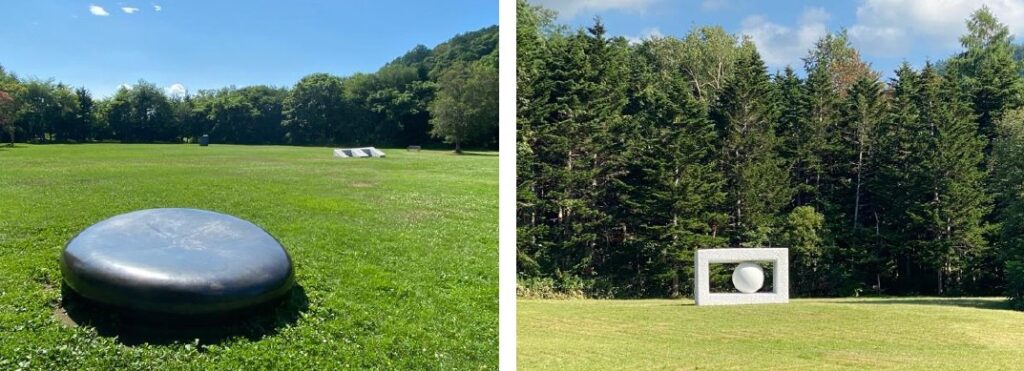
Inaugurated in 1992, the structure had a long and careful gestation behind it. In fact, since the 1980s, the artist had begun to place his sculptures in front of his studio in Bibai, near a school building that later fell into disuse. The park, which is always open to the public and is visited by around 30,000 people every year, has gradually been enriched with new works. Today, there are twenty-five outdoor works, while another eighteen are kept in the former school that has become a museum.
An immediately obvious aspect of Yasuda’s sculptures is their tactile and architectural character. Not only can one touch them, but one can freely enter, sit and lie in them, in a crossing of spaces that presents a continuous alternation of solids and voids. The sculptures have been exhibited several times in Italian cities, placed in the streets of Milan, Florence, Assisi, Rome, Pisa, Pietrasanta, Viareggio. Just a few months ago, in Torre del Lago Puccini, on the occasion of the festival dedicated to the composer, Madama Butterfly was performed with sets by the artist 〈3〉.
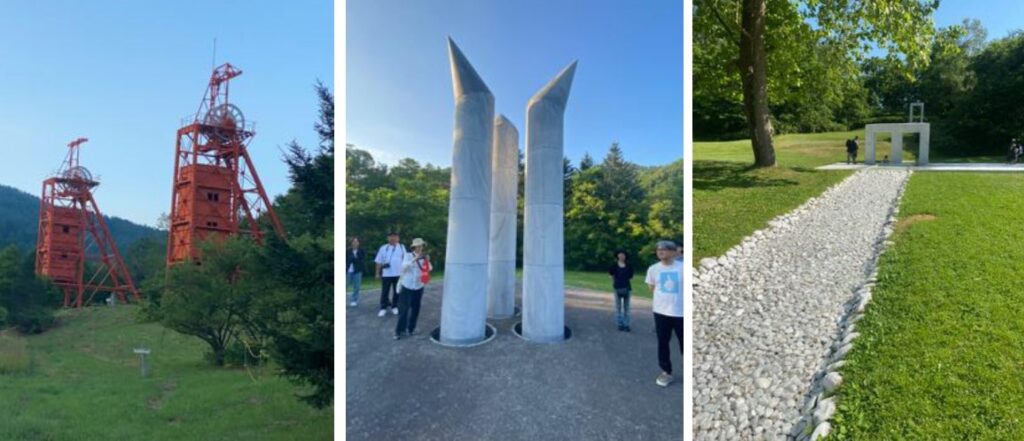
But it is in Bibai that the close connection of Yasuda’s sculptures to their surroundings comes to the fore. The vegetation, the water, the sky, the changing seasons, and, last but not least, the eye of the beholder create a total work of art. In addition to the natural dimension, there is a no less important ethical one, linked to the place where the mine was operated. In fact, Yasuda has dedicated a monument to the workers who fell victim to the collapse of the tunnels and has installed other of his works among the industrial remains that survived the closure of the operation.
The sculptures in the park are “living” and as such are in constant need of maintenance. Every day before opening, each one is dusted. Fallen leaves on the outdoor sculptures are removed, as well as traces of sweat and grease from hands. The running water installation and the pond – a joy for the children who bathe in it during the warm months – are made of marble pebbles from the Carrione stream, which rises in Colonnata and flows towards the sea as it crosses the town of Carrara. In order to prevent the proliferation of algae, the park’s pebbles are washed once a year in an intensive two-week operation.
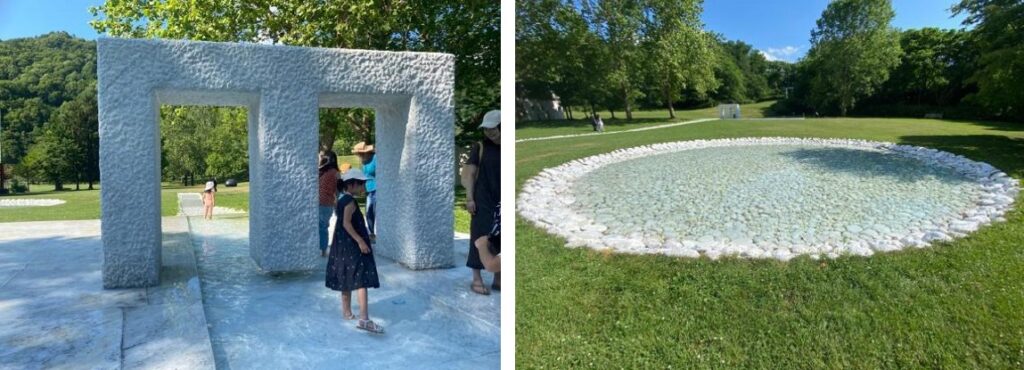
The park is an integral part of a forested area that is home to numerous animal species, including, often visible, deers and, in more remote areas, bears. Many people contribute to the management of the park. With their diligent work, the gardeners make this place a splendid interpretation of the art of traditional Japanese gardens: a serene environment where the perception of the sculptural work varies with the passing of time and the seasons. As Bruno Munari observed, with the simplicity and perspicacity that have always characterized him, in a text he wrote on the occasion of 1991 Yasuda’s exhibition in Milan: «Di fronte a questo tipo di opere si resta lì incantati a osservare. Sembra di vedere qualcosa di spontaneo, di naturale, come se fosse qualcosa di sempre esistito, qualcosa prodotto dalla natura» 〈4〉.
Strangely enough, the park also attracts visitors in winter, when snowfalls of up to two meters are common due to disturbances from Siberia. In preparation for the cold season, it is up to the caretakers to cover the sculptures with waterproof tarpaulins and woolen coats. When the snow arrives, trails are opened to allow people to travel to see the sculptures. Even the covered works, though not directly visible, retain a strong sculptural physiognomy that maintains their power of attraction.
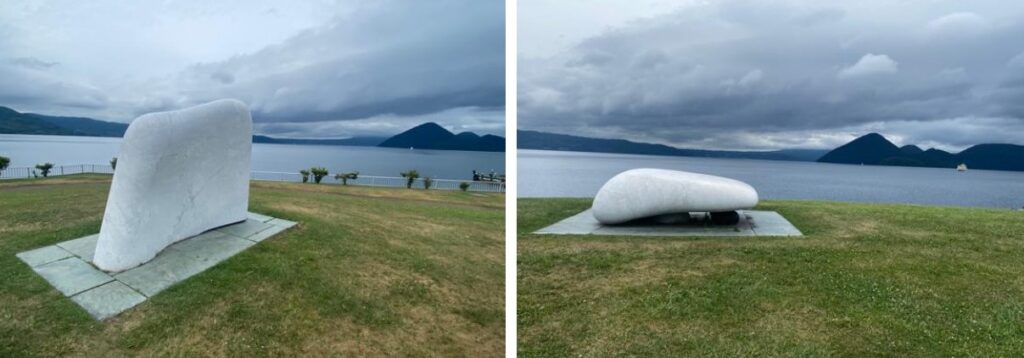
It is also unique to be confronted with sculptures in Apuan marble – usually and inappropriately called “Carrara” – in a country where the most common stone material is that of volcanic origin, especially granite, in all its variations and hues. Yasuda is not the only Japanese artist to have favored this exquisite Italian stone and to have made it known and appreciated in his homeland. But the record for the number and size of works scattered throughout Japan certainly belongs to him. Anyone who travels to Tokyo, Kyoto, Osaka, and other major cities in the country is bound to come across his striking white marble monoliths sooner or later.
Giorgio Angeli’s sculpture studio in Querceta has been the place where most of Yasuda’s marble sculptures have been materialized since 1974 〈5〉. With Angeli, the artist has had a decades-long relationship based on the expertise of Tuscan craftsmen. As for the other material that Yasuda is particularly fond of, bronze, the artist’s regular interlocutors are the Mariani foundries in Pietrasanta and, more recently, the Japanese steel company Kurotani.
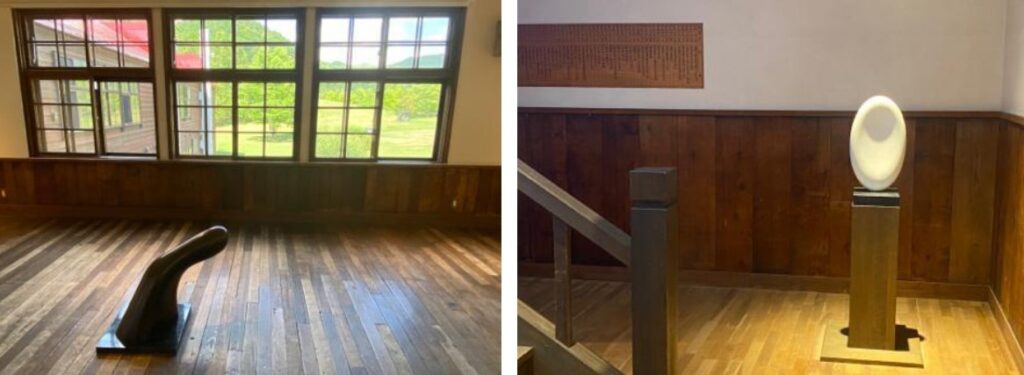
Yasuda Kan has captured the deepest essence of the Japanese tradition of reducing forms to the essential. It is his way of feeling, not too far from that of Arturo Martini, who, in his own colorful style, echoed a remark by Michelangelo Buonarroti: «Detto di Michelangelo, che buttando giù dalla montagna una statua, quello che resta è scoltura e quello che è scomparso è fronzolo. Cioè il ritorno al sasso» 〈6〉.
〈1〉 Here we follow the Japanese custom, according to which the surname precedes the first name, both in writing and in conversation. The same criterion applies to Tsuchiya Asuka, co-author of this article with Augusto Giuffredi.
〈2〉 The full name of the park-museum in English: Kan Yasuda Sculpture Museum - Arte Piazza Bibai. The official website: www.artepiazza.jp. See also the photo book The Art Plaza of Kan Jasuda - The Arte Piazza Bibai, published in 2002 by "Hokkaido Shimbun Press".
〈3〉 The performance was held on May 25 and June 8, 2024, as part of the LXX Puccini Festival, commemorating the 120th anniversary of the premiere of Puccini's masterpiece. There have been other performances of Madama Butterfly with sets by Yasuda in the past. Some of Yasuda's italian exhibitions: Kan Yasuda. Percorso della scultura, Milan, April-September 1991 (catalog edited by E. Santarella, with texts by B. Munari and I. Noguchi, Milan 1991); Kan Yasuda. Firenze, sculture in città, Florence, July-September 2000 (catalog with texts by R.M. di Giorgi, M.A. Lolli Ghetti, A. Paolucci, E. Crispolti, A. Ortuño, M. Falciano, Polistampa, Florence 2000); Kan Yasuda. Materia eterea, Marina di Pietrasanta, July-August 2003 (catalogue with texts by M. Iseki, F. Licht, Edizioni Monte Altissimo, Lucca 2003); Kan Yasuda. D'aria, di terra, d'acqua, di fuoco, Assisi, June-October 2005 (catalog with texts by Fr. V. Coli and H. Kawai); Kan Yasuda. Toccare il tempo, Rome, Mercati Traianei, September 2007-March 2008 (catalog with texts by L. Ungaro and F. Licht, Skira, Milan 2007); Kan Yasuda. Toccare il tempo, Pisa, June-October 2016 (catalogue with text by A. Paolucci, Pacini, Pisa 2016).
〈4〉 «In front of this kind of work, one stands enchanted to observe. One seems to see something spontaneous, something natural, as if it were something that has always existed, something produced by nature». B. Munari, Kan Yasuda, in Kan Yasuda. Percorso della scultura, op. cit.
〈5〉 On the Angeli workshop: U. Collu, Il marmo dell'altra mano. Studio di Scultura Giorgio Angeli, Ilisso, Nuoro 2021.
〈6〉 «Michelangelo said that when you throw a statue down from a mountain, what remains is sculpture and what has disappeared is frippery. That is, the return to stone». A. Martini, Colloqui sulla scultura 1944-1945, collected by G. Scarpa, edited by N. Stringa, Canova, Treviso 1997, p. 77.
Homepage: a winter view of the park with the tour route traced in the snow (hokkaido-digital-museum.jp).
Below: two bronze sculptures in the middle of the woods; the inside of the former school turned into a museum (photo credits Augusto Giuffredi).



